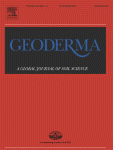Ver ítem
- xmlui.general.dspace_homeCentros Regionales y EEAsCentro Regional La Pampa - San LuisEEA San LuisArtículos científicosxmlui.ArtifactBrowser.ItemViewer.trail
- Inicio
- Centros Regionales y EEAs
- Centro Regional La Pampa - San Luis
- EEA San Luis
- Artículos científicos
- Ver ítem
Soil dry aggregate stability and wind erodible fraction in a semiarid environment of Argentina
Resumen
The size and stability of soil aggregates are primary factors that affect the soil susceptibility to wind erosion. Relationships among several soil properties and both the wind erodible fraction (EF) and the dry aggregate stability (DAS) can allow the development of simple mathematical models which can be useful to quantify soil resistance against wind erosion. Considering this we studied 28 cultivated (CULT) and uncultivated (UNCULT) soils of the central
[ver mas...]
The size and stability of soil aggregates are primary factors that affect the soil susceptibility to wind erosion. Relationships among several soil properties and both the wind erodible fraction (EF) and the dry aggregate stability (DAS) can allow the development of simple mathematical models which can be useful to quantify soil resistance against wind erosion. Considering this we studied 28 cultivated (CULT) and uncultivated (UNCULT) soils of the central semiarid region of Argentina with variable clay, organic carbon (OC), CaCO3, and amorphous Al (Alo) and Fe (Feo) oxides contents. Results showed that cultivation increased EF and reduced DAS in medium textured soils (silt + clay between 215 and 500 g kg−1), but not in sandy (silt + clay < 215 g kg−1) nor in fine textured soils (silt + clay > 500 g kg−1). Cultivation of medium textured soils produced the weakening of soil structure through the loss of OC and the breaking down of aggregates. These soils did not contain enough inorganic cementing agents like clay or Alo, which may avoid the deterioration of soil structure. In fine textured soils the formation of large and resistant clods by tillage of cultivated soils produced more similar EF and DAS than in uncultivated conditions. It seems that the lack of EF and DAS differentiation between management systems in sandy soils were produced by their low contents of organic and inorganic cementing agents, even in uncultivated conditions. EF and DAS were related to OC, Alo and clay contents in a logarithmic or an exponentially way. Such relationships allowed the identification of critical OC, Alo and clay contents below which the resistance of the soil against wind erosion is reduced drastically. DAS showed critical values at OC contents of 10 g kg−1 in CULT and 29 g kg−1 in UNCULT and clay contents of 100 g kg−1 in UNCULT. Alo critical contents were 1000 g kg−1 for EF and DAS in both managements. There were no effects of Feo and CaCO3 on EF and DAS in the studied soils. We concluded that the control of wind erosion requires different technologies according to soil texture: management practices which tend to increase the organic matter contents can be successful for the development of large and resistant aggregates which are effective in controlling wind erosion in medium textured soils. The large and stable clods formed by tillage in cultivated fine textured soils are effective in controlling wind erosion. In sandy soils, probably management practices which tend to increase the amount of organic cementing agents of the soil will not be effective in controlling wind erosion. Such goal must be achieved through the increase of coverage of the soil surface with plant residues or canopy.
[Cerrar]

Fuente
Geoderma 159 (1–2) : 228-236. (October 2010)
Fecha
2010-10
ISSN
0016-7061
Formato
pdf
Tipo de documento
artículo
Palabras Claves
Derechos de acceso
Restringido
 Excepto donde se diga explicitamente, este item se publica bajo la siguiente descripción: Creative Commons Attribution-NonCommercial-ShareAlike 2.5 Unported (CC BY-NC-SA 2.5)
Excepto donde se diga explicitamente, este item se publica bajo la siguiente descripción: Creative Commons Attribution-NonCommercial-ShareAlike 2.5 Unported (CC BY-NC-SA 2.5)

